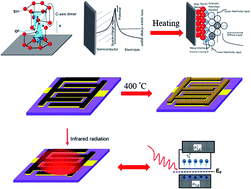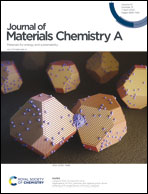Anomalous electrochemical capacitance in Mott-insulator titanium sesquioxide†
Abstract
Electrochemical capacitors with pure electric double-layer capacitance have so far been largely limited to carbon materials. Conventional metal oxides with faradaic pseudocapacitance substantially suffer from material instability at high temperatures, and thus there is a demand for novel metal oxides exhibiting improved high electrochemical capacitance with material stability. In this study, titanium sesquioxide, Ti2O3, a Mott-insulator in its metallic state at 300 °C, shows an anomalous increase of ∼560% in its solid-state electrochemical capacitance as compared to its pristine response at room temperature (RT). In an aqueous electrolyte, a maximum capacitance of 1053 μF cm−2 was obtained, which is 307% higher than that with solid-state electrolytes. Moreover, the semiconducting state of Ti2O3 demonstrated ∼3500% enhancement in its electrochemical capacitance upon infrared illumination at RT. The observed electrochemical responses of Ti2O3 are attributed to the transition from the semiconducting state to the metallic state by redistribution of localized electrons. Our experimental results find a good agreement with the first-principles density functional theory calculations that revealed an increase in charge density with a rise in temperature, which is mainly attributed to the surface Ti atoms. The study opens up wide avenues to engineer the electrochemical capacitance of Ti2O3 with high thermal stability.

- This article is part of the themed collection: Showcasing recent research in materials chemistry from IIT Bombay, IIT Indore and IISc


 Please wait while we load your content...
Please wait while we load your content...